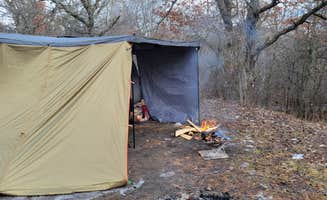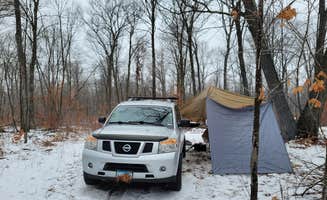Dispersed camping near Clearwater, Minnesota concentrates on public lands managed by the Minnesota Department of Natural Resources. Located within the central Minnesota region characterized by mixed forests, sandy soil, and multiple waterways, these areas experience seasonal extremes with winter temperatures dropping below freezing and summer humidity attracting significant insect activity. Most dispersed sites sit at elevations between 950-1,100 feet above sea level and feature secondary forest growth following historical logging operations.
What to do
Birdwatching opportunities: South of Sand Dunes State Forest offers exceptional bird diversity. "This is a nice quiet area... lots of different bird sounds," reports Jason B., who documented numerous species during spring migration. Bird activity peaks during early mornings.
Wildlife tracking: Rum River State Forest provides excellent wildlife viewing chances throughout the area. "We did encounter a lot of birds as well as deer," notes Art S., who spotted tracks along forest roads. Winter campers report more dramatic encounters: "I did hear wolves for the first time. They were howling after sunset," shares Johnny H.
Off-grid disconnection: Campers seeking digital detox find ideal conditions at these sites. "Bring a journal and some good company—your phone's chances are slim," writes one South of Sand Dunes visitor, referring to limited connectivity in most areas. Exception: some Rum River sites maintain decent signal strength.
What campers like
Accessibility from Minneapolis: Most dispersed sites require only an hour's drive from the Twin Cities. "I love that it's so close to home. I was able to walk in and find an incredible spot to camp and lay in my hammock," says Joslyn H. about South of Sand Dunes State Forest.
Solitude on weekdays: Mid-week camping offers the quietest experience. "I spent 3 days here with only one car passing through on the first night. After that, nothing!" remarks Skip H. about his experience at Rum River State Forest.
Multiple site options: The dispersed areas provide varied camping environments. "There are many different sites (most just pull offs) in this area! I did see one that was pull through further down game refuge road," notes Erin G. Most locations have established fire rings and cleared areas for tents.
What you should know
Vehicle considerations: Most forest roads range from well-maintained gravel to challenging dirt tracks. "The roads aren't really kept up for the winter. So, you'll want 4 wheel drive and slow and mindful driving," advises Johnny H. about winter access to dispersed sites.
Tick and insect management: Ticks pose a significant hazard throughout the camping season. "After finding a tick quickly we just hiked along the road," reports one Rum River visitor who altered plans accordingly. Another camper notes, "The bugs are not good but that's just what you're going to get in an area like this."
Traffic patterns: Some forest roads experience unexpected traffic. Ryan P. warns about Sand Dunes conditions: "This road is pretty busy for a dirt forest road and people FLY down it. Almost got hit a few times walking. Even through a Wednesday night cars are flying down the road."
Tips for camping with families
Space management: Several sites accommodate families with multiple tents. "Plenty of spots. Fairly small spots," notes Ryan P. about Sand Dunes areas. For larger family setups, Rum River typically offers more spacious clearings.
Wildlife education opportunity: The diverse wildlife provides learning experiences for children. "We did encounter a lot of birds as well as deer," reports Art S. One Sand Dunes visitor advises: "Stand storks are very protective. Stay away from them. They attack," offering a memorable nature lesson.
Site selection strategy: Families should scout locations before committing. "I just did an overnight camp one night in a truck camper and it was very easy to navigate and it was clean quiet area to spend the night," shares Adam W. about South Sand Dunes. However, he cautions that "a lot of the side roads are closed to motor vehicles" due to past dumping issues.
Tips from RVers
Rig size limitations: Most sites accommodate smaller trailers, but options exist for larger units. "7/7/1921 pull off sites big have a 37 ft fifth wheel no problem nice an quiet," shares Ronney P. about his experience at Rum River State Forest.
Site access verification: RV campers should confirm regulations before setting up. "Be aware if you have an RV though. I had a county sheriff person tell me it's not lawful to park a trailer and they kicked me out. I called the DNR and they said that wasn't right but I decided to leave anyway," warns Jason B. about inconsistent enforcement.
Pull-through availability: Limited pull-through sites exist but require searching. "There are a few spots that have great views or pull-through areas, and there are limited spots that are big-rig friendly," notes samuel C. who recommends arriving early to secure these premium locations.



